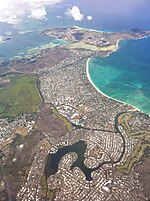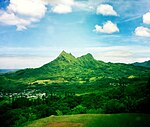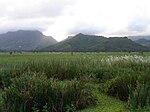Kaʻelepulu Pond
Kaʻelepulu Pond, also known as Enchanted Lake, is an estuary in Kailua, Hawaii. The Hawaiian name Kaʻelepulu literally means "moist blackness". Historically a 200-to-400-acre (81 to 162 hectare) Hawaiian fish pond, and later a fishery made up of 190 acres (77 hectares) of water and 90 acres (36 hectares) of marsh, Kaʻelepulu was partially filled in and built on beginning in 1959. Today the pond covers about 95 acres (38 hectares) in total, including wetland and some small islands, and has been subject to fish kills and algal blooms as a result of pollution from surface runoff; the Enchanted Lake Residents Association advises residents not to eat anything taken from it.
Excerpt from the Wikipedia article Kaʻelepulu Pond (License: CC BY-SA 3.0, Authors).Kaʻelepulu Pond
Keolu Drive, Kailua Enchanted Lake
Geographical coordinates (GPS) Address Nearby Places Show on map
Geographical coordinates (GPS)
| Latitude | Longitude |
|---|---|
| N 21.38 ° | E -157.74 ° |
Address
Keolu Drive
96735 Kailua, Enchanted Lake
Hawaii, United States
Open on Google Maps







